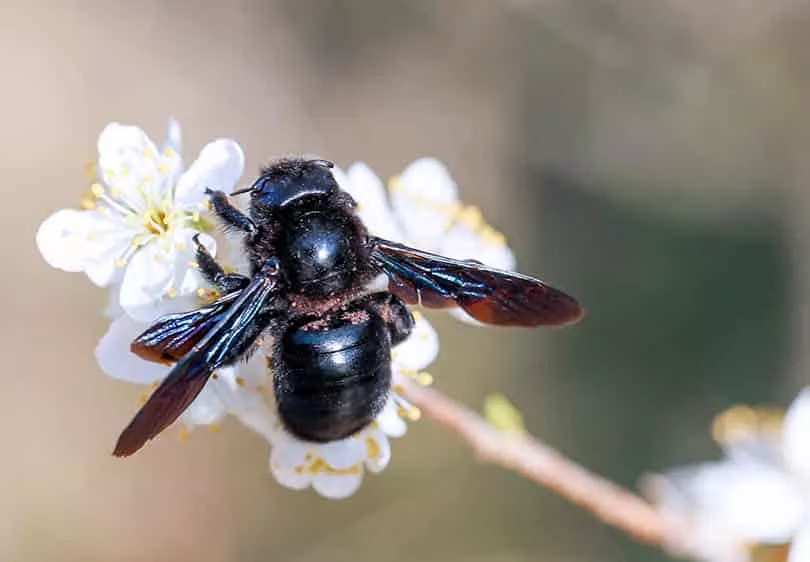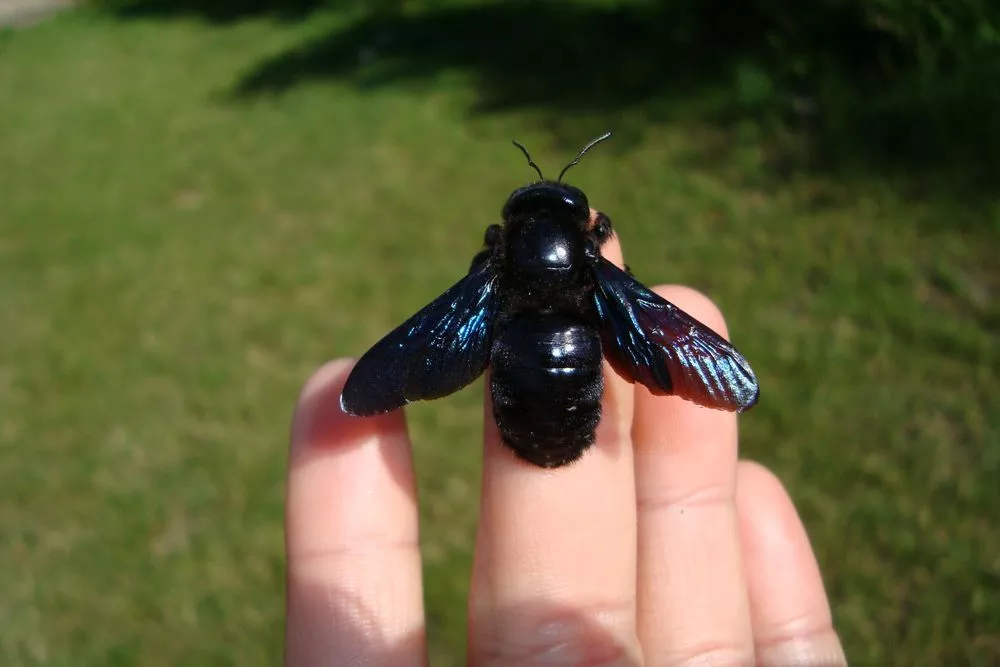Bees are essential pollinators that play a crucial role in maintaining the biodiversity of our ecosystems. Among the various species of bees, one that often captures attention and curiosity is the “Big Black Bee.” With their impressive size and striking appearance, these bees can both fascinate and raise concerns among people.
In this comprehensive blog post, we will delve into the world of Big Black Bees, exploring their characteristics, behavior, and ways to identify them. Whether you are a nature enthusiast, a gardener, or someone who’s encountered these bees in your backyard, this guide will help you gain a deeper understanding of these intriguing creatures.

What are Big Black Bees?
Big Black Bees, also known by their scientific name Xylocopa species, are a group of solitary bees that belong to the family Apidae. They are one of the largest bee species found across various regions of the world. These bees are renowned for their dark black or dark blue metallic sheen, which gives them an impressive and sometimes intimidating appearance. However, despite their size, they are not aggressive and typically pose little threat to humans.
Physical Characteristics of Big Black Bees
Big Black Bees are distinguished by their size and striking coloration. Here are some key physical characteristics:
| Characteristic | Description |
| Size | Large and robust, ranging from 1 to 1.5 inches in length |
| Coloration | Deep black or dark blue with a metallic sheen |
| Wings | Dark-colored wings, often with a slight iridescence |
| Abdomen | Shiny and hairless abdomen |
| Behavior | Solitary and non-aggressive |
Habitat and Distribution
Big Black Bees have a diverse habitat range, and their distribution varies depending on the species. These bees are commonly found in:
- Forested areas
- Gardens and urban spaces
- Deserts and arid regions
- Coastal regions
Behavior and Social Structure
Big Black Bees are solitary creatures, unlike their honeybee relatives, which live in colonies. They lead independent lives and do not form large nests or hives. Each female bee creates her own nest by burrowing into wood or other suitable materials. These nests serve as brood chambers where the bee lays her eggs and provides pollen and nectar as food for the developing larvae.
Despite being solitary, Big Black Bees are not territorial and can often be found in proximity to one another, especially in areas with abundant food sources.
Importance of Big Black Bees in Ecosystems
Big Black Bees are crucial pollinators for many plant species, including wildflowers, fruit trees, and crops. As they forage for nectar, they inadvertently transfer pollen from one flower to another, facilitating the process of plant reproduction. This activity supports the growth of plants and ensures genetic diversity within plant populations, benefiting the overall ecosystem.
Common Misconceptions and Myths
There are several misconceptions and myths surrounding Big Black Bees, leading to misunderstandings about their behavior and potential danger to humans. Let’s debunk some of these myths:
Myth 1: Big Black Bees are aggressive and sting without provocation.
In reality, Big Black Bees are non-aggressive and rarely sting humans. They are more interested in foraging for food and building their nests than engaging in defensive behavior.
Myth 2: All Big Black Bees belong to the same species.
Big Black Bees comprise several species within the Xylocopa genus. Each species has unique characteristics and behavior.
Myth 3: Big Black Bees damage wooden structures.
While they nest in wood, they do not consume the wood or cause significant damage to structures.

Identifying Big Black Bees vs. Other Bee Species
Identifying Big Black Bees can sometimes be challenging, as they may resemble other large bee species. Here are some distinguishing features that can help you differentiate them from other bees:
| Feature | Big Black Bees | Other Bee Species |
| Size | Large, robust body | Varied sizes |
| Coloration | Dark black or dark blue | Varies by species; not always black |
| Abdomen | Shiny and hairless | May have hair or stripes on abdomen |
| Behavior | Non-aggressive | Can be aggressive depending on species |
Attracting and Protecting Big Black Bees in Your Garden
If you wish to encourage Big Black Bees to visit your garden and contribute to pollination, consider implementing the following tips:
- Plant Native Flowers: Choose a variety of native plants that provide nectar and pollen as food sources.
- Create Nesting Sites: Leave dead wood or hollow stems in your garden to serve as potential nesting sites for these solitary bees.
- Avoid Pesticides: Minimize or eliminate the use of chemical pesticides, as they can harm bees and other beneficial insects.
Safety Precautions and Dealing with Nests
While Big Black Bees are generally harmless to humans, it’s essential to exercise caution if you encounter their nests in or around your property. If you need to remove a nest, consider the following safety precautions:
- Observe from a Distance: Keep a safe distance from the nest and observe the bees’ behavior before deciding on any action.
- Night Removal: If removal is necessary, do it at night when the bees are less active.
- Seek Professional Help: If you are uncertain or uncomfortable dealing with the nest, consult a local beekeeper or pest control expert.
Conclusion
Big Black Bees are magnificent pollinators with an essential role in maintaining the health and diversity of our ecosystems. Despite their striking appearance, they are generally docile and provide numerous benefits to the environment. By understanding their characteristics and behavior, we can coexist with these bees and appreciate the valuable work they do.
So, the next time you spot a Big Black Bee buzzing around your garden, take a moment to appreciate its presence and the important role it plays in nature. Remember, these bees are not aggressive and are more interested in gathering nectar and pollen than causing harm to humans.
By providing a welcoming environment for Big Black Bees in your garden, you can contribute to the preservation of these fascinating creatures and support the overall health of your local ecosystem. Planting native flowers, creating nesting sites, and avoiding harmful pesticides are simple yet effective ways to attract and protect these valuable pollinators.
As you learn more about Big Black Bees and their behavior, you’ll likely dispel common misconceptions and myths that often lead to unnecessary fear and misconceptions about these beneficial insects. Knowledge is a powerful tool in promoting harmony between humans and the natural world.
In conclusion, Big Black Bees are awe-inspiring insects that deserve our admiration and protection. As pollinators, they play a vital role in the reproduction of various plant species, contributing to the biodiversity and sustainability of our environment. By understanding their characteristics, habitat, and behavior, we can create a more welcoming space for them in our gardens and appreciate their role in the intricate web of life.
So, the next time you come across a Big Black Bee, take a moment to marvel at its beauty and remember the significant impact it has on our world. Together, we can ensure that these magnificent bees continue to thrive and fulfill their crucial role as nature’s unsung heroes.
Remember, as responsible stewards of the environment, our actions, no matter how small, can make a big difference in the survival of these remarkable creatures. Let’s embrace the presence of Big Black Bees in our lives and celebrate the wonders of nature that surround us every day.
Happy gardening and happy bee-watching! 🌼🐝
Frequently Asked Questions (FAQ)
Q1: Are Big Black Bees dangerous?
A1: Big Black Bees are generally non-aggressive and pose little threat to humans.
Q2: How can I attract Big Black Bees to my garden?
A2: Plant native flowers and create nesting sites in your garden to attract these bees.
Q3: Do Big Black Bees sting?
A3: While they are capable of stinging, they are not prone to do so unless provoked.
Q4: What is the importance of Big Black Bees in ecosystems?
A4: They play a vital role as pollinators, supporting plant reproduction and biodiversity.
Q5: Can I remove a Big Black Bee nest on my own?
A5: It’s best to seek professional help or consult a local beekeeper for safe nest removal.
Q6: Do all Big Black Bees look the same?
A6: No, Big Black Bees consist of various species with unique characteristics.
Q7: Where can I find Big Black Bees?
A7: They can be found in forests, gardens, deserts, and coastal regions.
Q8: Do Big Black Bees cause damage to wooden structures?
A8: While they nest in wood, they do not typically cause significant damage.
Q9: How big do Big Black Bees grow?
A9: They can range from 1 to 1.5 inches in length.
Q10: Can I use pesticides to control Big Black Bees in my garden?
A10: Avoid using pesticides, as they can harm bees and other beneficial insects.

